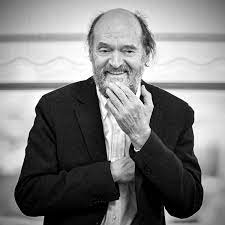Fratres (meaning “Brothers” in latin) is a musical work by the Estonian composer Arvo Pärt exemplifying his tintinnabuli style of composition It is three-part music, written in 1977, without fixed instrumentation and has been described as a “mesmerising set of variations on a six-bar theme combining frantic activity and sublime stillness that encapsulates Pärt’s observation that ‘the instant and eternity are struggling within us’.”
The main theme is strongly inspired by the movement Le Coucou au fond des bois from The Carnival of the Animals (1886) by Camille Saint-Saëns.
Structurally, Fratres consists of a set of nine chord sequences, separated by a recurring percussion motif (the so-called “refuge”). The chord sequences themselves follow a pattern, and while the progressing chords explore a rich harmonic space, they have been generated by means of a simple formula.
Fratres is driven by three main voices. The low and high voice are each restricted to playing notes from the D harmonic minor scale (D, E, F, G, A, Bb, C#); the middle voice is restricted to the notes of the A minor triad (A, C, E). The entire piece is accompanied by drones in A and E, which are primarily heard in the refuge between each sequence.
The chords are created by the movement of the three voices: the low voice starts at C#; the high voice starts at E. Both the low and high voices are moved up or down the D harmonic minor scale at the same time, with the direction of the movement depending on the position within the sequence. The middle voice starts at A and plays a different pattern (A, E, E, C, C, C, C, A, A, E, E, C, C, A). The generated chords create harmonic ambiguity, since both C# and C are present, yielding an A major or A minor feel.
The piece is often performed by violin and piano, but is also familiar in versions for larger forces such as a chamber orchestra. Performance by early music specialists has also been endorsed. All existing versions so far are composed as follows:
Versions of the original music in three voices
- chamber orchestra (1977)
- four, eight, twelve… cellos (1982)
- string quartet (1989)
- octet of winds and percussion (1990)
- string and percussion orchestra (1991)
- band of metal instruments (2004)
- three recorders, percussions and cello or viola da gamba (2009)
Versions of music in three voices with individual variations
- violin and piano (1980)
- cello and piano (1989)
- violin, string orchestra and percussion (1992)
- trombone, string orchestra and percussion (1993)
- cello, string orchestra and percussion (1995)
- guitar, string orchestra and percussion (2000)
- violet and piano (2003)
- four percussionists (2006)
- viola, string orchestra and percussion (2008)
- saxophone quartet (2010)
- Meer: Concertbezoek klassieke muziek
- Bronnen: funkystuff.org
- Uitgaand: Mahler Foundation
- Uitgaand: Concertgebouworkest
- Zoekwoorden:

